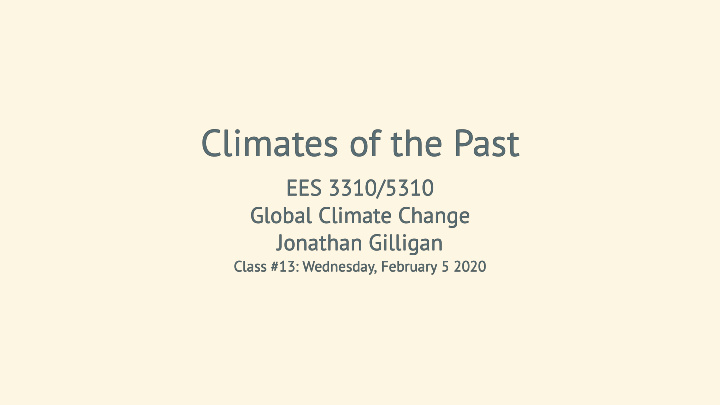



Climates of the Past Climates of the Past EES 3310/5310 EES 3310/5310 Global Climate Change Global Climate Change Jonathan Gilligan Jonathan Gilligan Class #13: Class #13: Wednesday, February 5 Wednesday, February 5 2020 2020
Announcements Announcements
Lab #2 Lab #2 Lab #2 has been graded Grades are posted in your GitHub repositories. Comments and points in red on your .docx file. Total score at the bottom of the last page. Answers are posted on the class web page Go to the lab assignment page and click on “ Solutions ”
Optional Extra Credit Optional Extra Credit Optional Extra Credit : If you are unhappy with your grade on part 1 of the homework, you can optionally do the following exercise for extra credit: You have seen one-layer and two- layer models of the atmosphere. Solve a three-layer model of the atmosphere, as shown here. Points on this will count toward making up any points you lost on part 1 of the Lab #2 assignment.
Knitting RMarkdown to Knitting RMarkdown to .pdf .pdf For future labs (optional): If you want to knit your documents to .pdf instead of .docx : One-time preparation… When you have some time to spare (this is slow): At the RStudio console, type the following commands: library (pacman) p_load (tinytex) install_tinytex () Now your computer is ready to knit to pdf. You only need to do this one time This is optional
Carbonate vs. Silicate Weathering Carbonate vs. Silicate Weathering
Carbonate vs. Silicate Weathering Carbonate vs. Silicate Weathering Carbonate Weathering: Dissolves carbonate minerals on land Increases ocean carbonate Adds twice as much carbonate to oceans as silicate weathering Relieves ocean acidification Increases transfer of CO 2 from atmosphere to ocean Creates carbonate rocks on sea floor with carbon that originated on land Does not transform atmospheric CO 2 to rocks Silicate Weathering: Transforms carbon dioxide in atmosphere into rocks Creates carbonate rocks on sea floor with carbon that originated in atmosphere
Equilibrium Balances Equilibrium Balances At Equilibrium: At Equilibrium: Silicate weathering = Rate of CO 2 emission (Before fossil fuels, CO 2 emission was just volcanic degassing) Total weathering (carbonate + silicate) = Rate of carbonate burial on sea-floor
Weathering as Thermostat Weathering as Thermostat
Weathering as Thermostat Weathering as Thermostat is balance of volcanic outgassing CO 2 and chemical weathering Higher temperatures: More rain, faster chemical reactions Faster weathering Atmospheric falls CO 2 Lower temperatures Less rain, slower chemical reactions Slower weathering Atmospheric rises CO 2
Temperature of Earth Temperature of Earth Weathering acts as thermostat. Earth’s temperature has been remarkably stable over time. 4 billion years ago, sun was 30% dimmer… But there has constantly been liquid water. Geologic change alters thermostat “setting”: Volcanic outgassing Land surface (e.g., mountain ranges) Vascular plants In the long run, silicate thermostat will fix global warming… …but it will take tens to hundreds of thousands of years.
Climates of the Past Climates of the Past
Climates of the Past Climates of the Past
Climates of the Past Climates of the Past
Climates of the Past Climates of the Past
Digging into the past Digging into the past
Digging into the past: Digging into the past: The last 130 years The last 130 years
Surface Temperature Monitoring Surface Temperature Monitoring 7280 stations 2277 active 1656 > 100 years
Temperature Anomaly Temperature Anomaly Global temperature change: Average temperatures are different at different places. Temperatures change with the seasons How to compare temperature change between places with different climates? Temperature anomaly: Define a reference time period (several decades) Anomaly = actual temperature at a place and time minus average temperature at that place during reference period
Temperature Anomaly Temperature Anomaly Anomaly = actual temperature at a place and time minus average temperature at that place during reference period Example: Anomaly for Nashville, January, 2020 Monthly avg. temp. for January, 2020 = 7.2 ∘ C Average January temp 1950–1979 = 3.0 ∘ C Anomaly = 7.2 ∘ 3.0 ∘ 4.3 ∘ C − C = C
Global Anomaly Global Anomaly 1850–2012 1850–2012
North America North America 1850–2012 1850–2012
Continental US Anomaly Continental US Anomaly 1850–2012 1850–2012
Tennessee Anomaly Tennessee Anomaly 1850–2012 1850–2012
Nashville Anomaly Nashville Anomaly 1850–2012 1850–2012
Ocean Temperatures Ocean Temperatures
Ocean Temperatures Ocean Temperatures
Ocean Temperatures Ocean Temperatures
Ocean Heat Content Ocean Heat Content
Searching for Searching for a Smoking Gun: a Smoking Gun:
What caused the warming? What caused the warming?
Sunspots? Sunspots?
Sunspots? Sunspots? Sunspots Sunspots More sunspots brighter → 11 year cycle Intensity changes: <1% for 11-year cycle <0.1% change in decadal average from little ice age to present
Sunspots didn’t cause recent warming Sunspots didn’t cause recent warming
Fingerprints: Fingerprints: Predictions and Patterns Predictions and Patterns
Predictions: 1967 Predictions: 1967
Stratosphere vs. Surface: Stratosphere vs. Surface:
Day vs. Night Day vs. Night
Recommend
More recommend